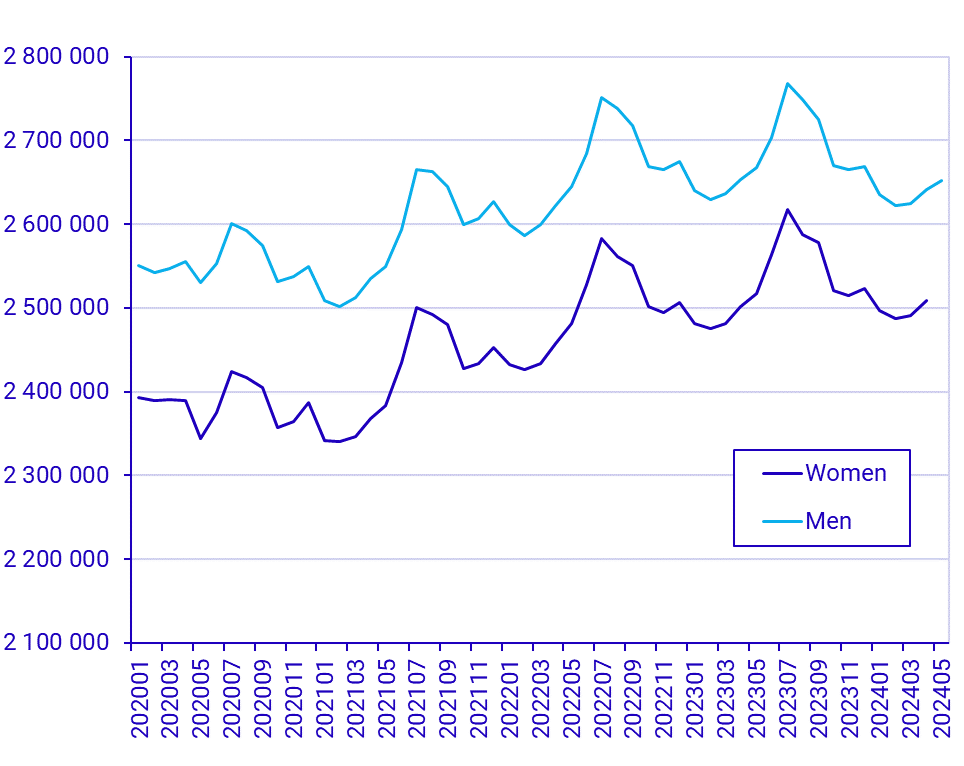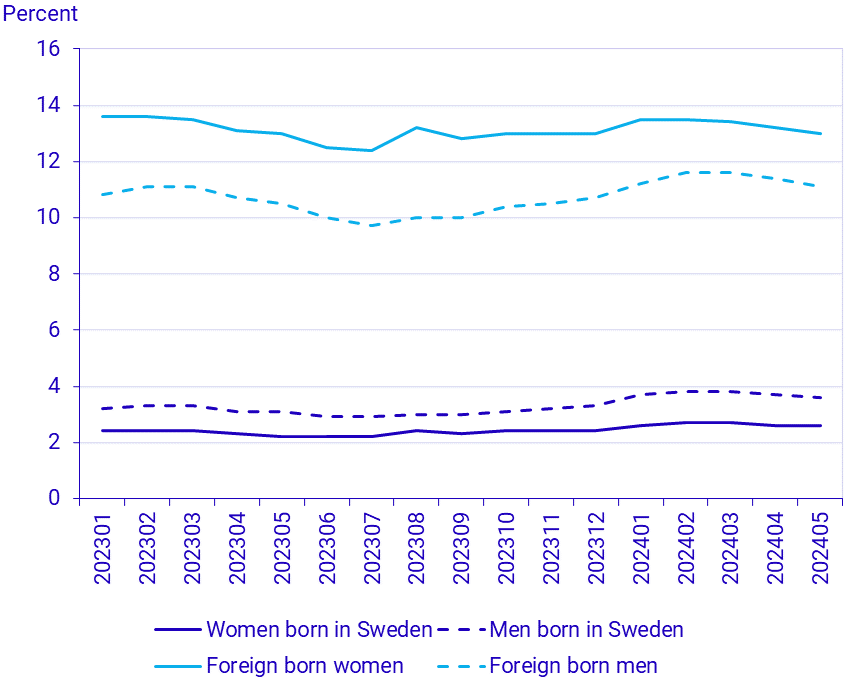Population by Labour market status, May 2024
Unemployment continued to increase in May 2024
Statistical news from Statistics Sweden 2024-07-31 8.00
People in employment aged 15 to 74 numbered 5 173 000 in May 2024. This is a decrease of 12 000 people compared with May 2023. In the 20 to 65 age range, 271 000 people were unemployed. This equals a share of 5.3 percent expressed as a percentage of the labour force and is an increase of 0.4 percentage point compared with the same period of the previous year.
People in employment
The number of people in employment aged 15 to 74 decreased in May 2024 by 12 000 compared with the same period of 2023, amounting to 5 173 000. Fewer women than men were employed. A total of 2 520 000 women and 2 652 000 men were employed.

In the 20 to 65 age range the employment rate – the number of employed people in relation to the population – was 79.4 percent in May 2024. The employment rate among women was 79.1 percent and 79.8 percent among men. Compared with May 2023, the employment rate was unchanged among women, while the employment rate among men decreased by 0.4 percentage points.
The unemployed
The number of unemployed people aged 20 to 65 in May 2024 was 271 000, which is an increase of 23 000 compared to the same period the previous year. A total of 127 000 women and 143 000 men were unemployed.
The relative unemployment rate - the proportion of unemployed people in relation to the labour force - was 5.1 percent for women and 5.5 percent for men. This equals an increased unemployment rate among woman of 0.3 percentage point, and 0.6 percentage point among men compared with the same period of 2023.
Unemployment is higher among foreign born people than among those born in Sweden. The relative unemployment rate was, among foreign born people, 13.0 percent for women and 11.1 percent for men. For people born in Sweden the relative unemployment rates was 2.6 percent for women and 3.6 percent for men in May 2024.

| Maj 2024 | April 2024 | Maj 2023 | Change since May 2023 (%) | |
|---|---|---|---|---|
| Employed | 5 173 000 | 5 150 000 | 5 185 000 | ‑0.2 |
| Men | 2 652 000 | 2 641 000 | 2 668 000 | ‑0.6 |
| Women | 2 520 000 | 2 509 000 | 2 517 000 | 0.1 |
| Men born in Sweden | 2 040 000 | 2 033 000 | 2 056 000 | ‑0.8 |
| Women born in Sweden | 1 965 000 | 1 957 000 | 1 972 000 | ‑0.4 |
| Foreign born men | 612 000 | 608 000 | 612 000 | 0.0 |
| Foreign born women | 555 000 | 552 000 | 545 000 | 1.9 |
| Maj 2024 | April 2024 | Maj 2023 | Change since Maj 2023 | |
|---|---|---|---|---|
| Employed | 4 821 000 | 4 802 000 | 4 831 000 | ‑0.2 |
| Men | 2 476 000 | 2 465 000 | 2 489 000 | ‑0.5 |
| Women | 2 345 000 | 2 336 000 | 2 341 000 | 0.2 |
| Employment rate (%) | 79.4 | 79.1 | 79.6 | ‑0.2 |
| Men | 79.8 | 79.4 | 80.2 | ‑0.4 |
| Women | 79.1 | 78.8 | 79.1 | 0.0 |
| Men born in Sweden | 83.1 | 82.8 | 83.6 | ‑0.5 |
| Women born in Sweden | 83.7 | 83.4 | 83.8 | ‑0.2 |
| Foreign born men | 70.6 | 70.1 | 70.8 | ‑0.2 |
| Foreign born women | 66.6 | 66.2 | 66.0 | 0.6 |
| Unemployment | 271 000 | 277 000 | 248 000 | 9.1 |
| Men | 143 000 | 147 000 | 129 000 | 11.4 |
| Women | 127 000 | 129 000 | 119 000 | 6.6 |
| Men born in Sweden | 70 000 | 72 000 | 60 000 | 16.8 |
| Women born in Sweden | 48 000 | 48 000 | 42 000 | 14.5 |
| Foreign born men | 73 000 | 75 000 | 69 000 | 6.7 |
| Foreign born women | 80 000 | 81 000 | 78 000 | 2.3 |
| Relative unemployment rate (%) | 5.3 | 5.4 | 4.9 | 0.4 |
| Men | 5.5 | 5.6 | 4.9 | 0.6 |
| Women | 5.1 | 5.2 | 4.9 | 0.3 |
| Men born in Sweden | 3.6 | 3.7 | 3.1 | 0.5 |
| Women born in Sweden | 2.6 | 2.6 | 2.2 | 0.3 |
| Foreign born men | 11.1 | 11.4 | 10.5 | 0.6 |
| Foreign born women | 13.0 | 13.2 | 13.0 | 0.1 |
| Maj 2024 | April 2024 | Maj 2023 | Change since May 2023 (%) | |
|---|---|---|---|---|
| Students | 183 000 | 195 000 | 177 000 | 3.6 |
| Men | 81 000 | 85 000 | 78 000 | 3.5 |
| Women | 103 000 | 110 000 | 99 000 | 3.8 |
| Retirees | 76 000 | 77 000 | 99 000 | ‑23.2 |
| Men | 38 000 | 39 000 | 49 000 | ‑21.6 |
| Women | 38 000 | 39 000 | 50 000 | ‑24.8 |
| Sick | 227 000 | 227 000 | 221 000 | 2.6 |
| Men | 102 000 | 101 000 | 99 000 | 2.9 |
| Women | 125 000 | 125 000 | 123 000 | 2.4 |
| Others | 490 000 | 493 000 | 490 000 | 0.2 |
| Men | 263 000 | 265 000 | 261 000 | 0.8 |
| Women | 227 000 | 228 000 | 229 000 | ‑0.5 |
Definitions and explanations
BAS, Population by Labour market status, presents statistics based on administrative data concerning aspects such as number of people in employment, unemployed people, and people outside the labour force for the registered population aged 15 to 74. The statistics can be used to describe current status, but also the progression over time. It illuminates both the entire population and smaller groups, such as detailed age groups at the municipal level.
The statistics contain estimates of the number of people broken down by labour market status: Employed, unemployed, student, retiree, sick and others. The definition of labour market status is hierarchical, which means that a person can only be assigned one labour market status, and it is determined according to the order of precedence above.
The labour force consists of employed people and the unemployed.
The labour market status categories that are outside the labour force are student, pensioner, sick and others. There are fewer people outside the labour force in the summer than during other parts of the year. This is mainly because some people who are students during term time work during the summer and are then classified as employed.
Feel free to use the facts from this statistical news but remember to state Source: Statistics Sweden.
